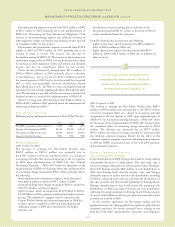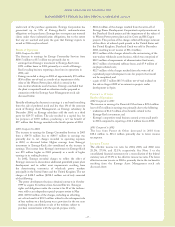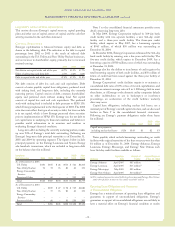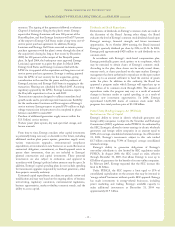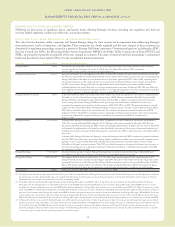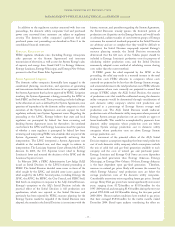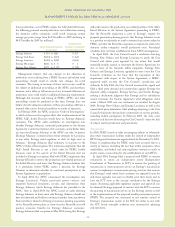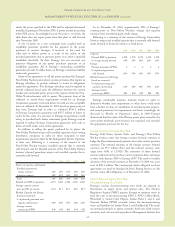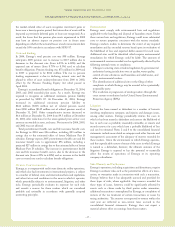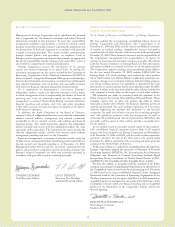Entergy 2004 Annual Report Download - page 38
Download and view the complete annual report
Please find page 38 of the 2004 Entergy annual report below. You can navigate through the pages in the report by either clicking on the pages listed below, or by using the keyword search tool below to find specific information within the annual report.
-36 -
Entergy Corporation and Subsidiaries 2004
future production costs if FERC adopts the ALJ’s Initial Decision,
the following potential annual production cost reallocations among
the domestic utility companies could result assuming annual
average gas prices range from $6.39/mmBtu in 2005 declining to
$4.97/mmBtu by 2009 (in millions):
Average Annual
Range of Annual Payments Payments or (Receipts)
or (Receipts) for 2005-2009 Period
Entergy Arkansas $ 154 to $281 $ 215
Entergy Gulf States $(130) to $ (15) $ (63)
Entergy Louisiana $(199) to $(98) $(141)
Entergy Mississippi $(16) to $ 8 $ 1
Entergy New Orleans $(17) to $ (5) $ (12)
Management believes that any changes in the allocation of
production costs resulting from a FERC decision and related retail
proceedings should result in similar rate changes for retail
customers. The timing of recovery of these costs in rates could be
the subject of additional proceedings at the APSC and elsewhere,
however, and a delay in full recovery of any increased allocation of
productioncosts could result in additional financing requirements.
Although the outcome and timing of FERC, APSC, and other
proceedings cannot be predicted at this time, Entergy does not
believethat the ultimate resolutionof these proceedings willhave a
material effect onits financial condition or results of operation.
In February 2004, the APSC issued an “Order of Investigation,”
in whichit discusses the negativeeffect that implementationof the
FERCALJ’s Initial Decision would have on Entergy Arkansas’
customers. The APSC order establishes an investigation into
whether EntergyArkansas’ continued participationin the System
Agreement is in the best interest of its customers, and whether there
aresteps that EntergyArkansas or the APSC can take “to protect
[EntergyArkansas’ customers] from future attempts by Louisiana,
or anyother Entergy retail regulator, to shift its high costs to
Arkansas.” Entergy Arkansas filed testimony in response to the
APSC’s Order of Investigation. The testimony emphasizes that the
ALJ’s Initial Decision is not a final order by FERC; briefly
discusses some of the aspects of the Initial Decision that are
included in Entergy’s exceptions filed with FERC; emphasizes that
Entergy will seek to reverse the production cost-related portions of
the Initial Decision; and states that Entergy Arkansas believes that
it is premature, before FERC makes a decision, for Entergy
Arkansas to determine whether its continued participation in the
System Agreement is appropriate.
In April 2004, the APSC commenced the investigation into
Entergy Louisiana’s Vidalia purchased power contract and
requested historical documents, records, and information from
Entergy Arkansas, which Entergy Arkansas has provided to the
APSC. Also in April 2004, the APSC issued an order directing
Entergy Arkansas to show cause why Entergy Arkansas should not
have to indemnify and hold its customers harmless from any adverse
financial effects related to Entergy Louisiana’s pending acquisition
of the Perryville power plant, or show that the Perryville unit will
produce economic benefits for Entergy Arkansas’ customers.
EntergyArkansas filed a response in May 2004 stating that Entergy
will seek to reverse the production cost-related portions of the ALJ’s
Initial Decision in the System Agreement proceeding at FERC,
that the Perryville acquisition is part of Entergy’s request for
proposal generation planning process, that Entergy Arkansas is not
in a position to indemnify its retail customers from actions taken by
FERC, and that the Perryville acquisition is expected to reduce the
domestic utility companies’ overall production costs. Procedural
schedules have not been established in these APSC investigations.
In April 2004, the City Council issued a resolution directing
Entergy New Orleans and Entergy Louisiana to notify the City
Council and obtain prior approval for any action that would
materially modify, amend, or terminate the System Agreement for
one or more of the domestic utility companies. Entergy New
Orleans and Entergy Louisiana appealed to state court the City
Council’s resolution on the basis that the imposition of this
requirement with respect to the System Agreement, a FERC-
approved tariff, exceeds the City Council’s jurisdiction and
authority. In July 2004, the City Council answered the appeal and
filed a third party demand and counterclaim against Entergy, the
domestic utilitycompanies, Entergy Services, and System Energy,
seeking a declaratoryjudgment that Entergyand its subsidiaries
cannot terminate the System Agreement until obligations owed
under a March2003 rate case settlement aresatisfied. In August
2004, Entergy New Orleans and Entergy Louisiana, as well as the
named third party defendants, filed pleadings objecting to the City
Council’sthirdpartydemand and counterclaim on various grounds,
including federal preemption. In February 2005, the state court
issued an oral decision dismissing the City Council’s claims for lack
of subject matter jurisdictionand prematurity.
Transmission
In 2000, FERCissued an order encouraging utilities to voluntarily
place their transmission facilities under the control of independent
RTOs (regional transmission organizations) by December 15, 2001.
Delays in implementing the FERC order have occurred due to a
variety of reasons, including the fact that utility companies, other
stakeholders, and federal and state regulators continue to work to
resolve various issues related to the establishment of such RTOs.
In April 2004, Entergy filed a proposal with FERC to commit
voluntarily to retain an independent entity (Independent
Coordinator of Transmission or ICT) to oversee the granting of
transmission or interconnection service on Entergy’s transmission
system, to implement a transmission pricing structure that ensures
that Entergy’s retail native load customers are required to pay for
only those upgrades necessary to reliably serve their needs, and to
have the ICT serve as the security coordinator for the Entergy
region. Assuming applicable regulatory support and approvals can
be obtained, Entergy proposed to contract with the ICT to oversee
the granting of transmission service on the Entergy system as well
as the implementation of the proposed weekly procurement process
(WPP). The proposal was structured to not transfer control of
Entergy’s transmission system to the ICT, but rather to vest with
the ICT broad oversight authorityover transmission planning
and operations.
MANAGEMENT’S FINANCIAL DISCUSSION and ANALYSIS continued


